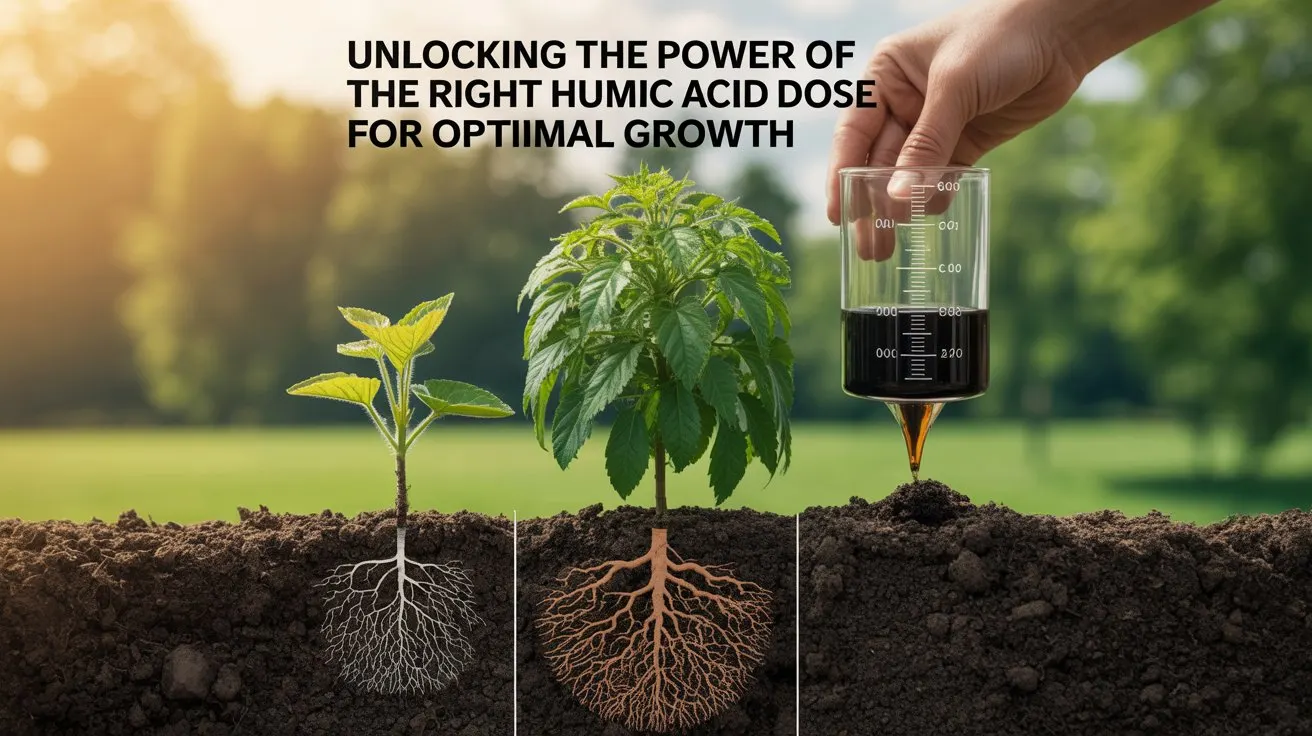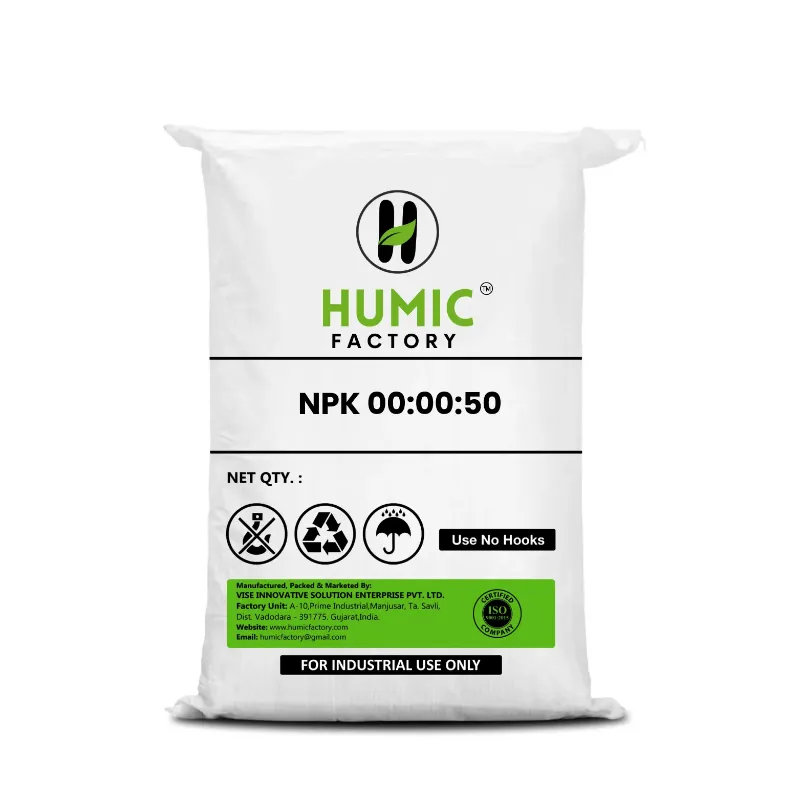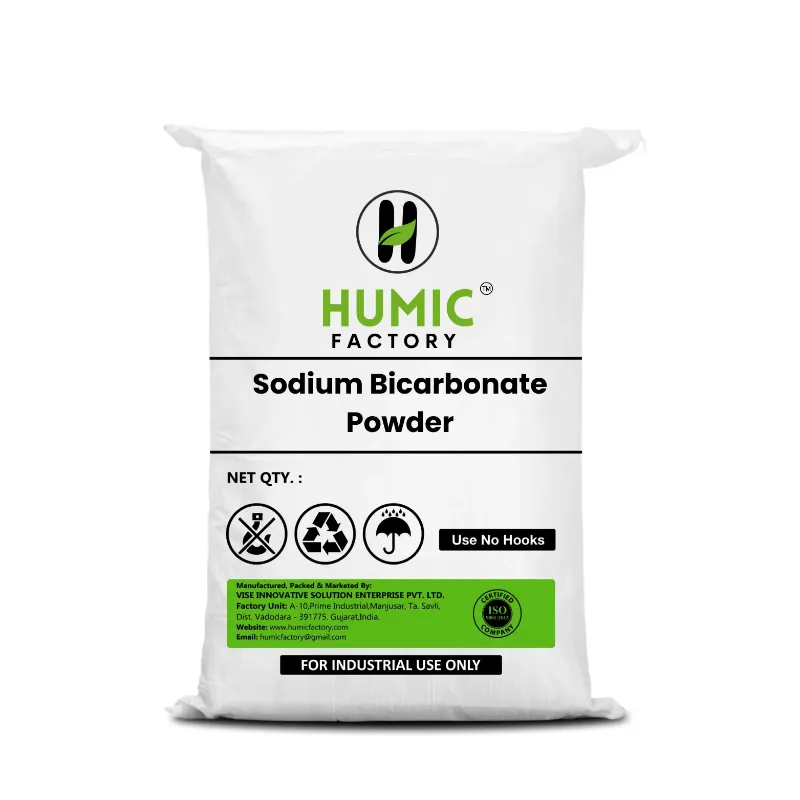Humic acid is a great means to promote soil health, stimulate plant growth and improve agricultural productivity. The best use of humic acid, however, depends on understanding how to determine the best dose of humic acid for your crops and soil. If dose is not adequately addressed, you will either not gain the full value of humic acid application or can cause nutrient imbalances if too much is applied. Humic acid can be used for both humic acid dosage for plants as well as humic acid dosage per litre. Proper dosage of humic acid will lead to drying the soil properly with good structure and good fertility retention that is high in nutrients; enhance flora and fauna and microbial activity that provides a healthier ecosystem; maximise nutrient access and uptake and stimulate root growth leading to maximised plant growth and yield that is assessed by correct humic acid dosage and application. Overuse of humic acid can cause nutrient imbalances, whilst underuse of humic acid will not yield the best results. The correct dose is directed to eliminate overuse and under using.
Introduction: Why the Right Humic Acid Dose is a Game-Changer
Humic acid is critical to soil quality improvement because of its impact on plant growth and sustainable agriculture. However, it is very important to know and use the appropriate humic acid dosage for plants for best results. Using the correct dosage will allow plants to fully benefit from humic acid without the risk of over-application which may cause nutrient imbalance or even undo the effectiveness of the humic acid.
Humic Acid’s Unique Role in Sustainable Growth
Humic acid is an organic compound that is made from the natural degradation of plant and animal materials. It adds organic matter to your soil, improves the structure of your soil and improves nutrient availability. When used at the correct humic acid dosage for plants, it increases soil fertility, improves nutrient retention, increases plant stress tolerance to drought or environmental stressors, while taking the nutrient upregulation one step further.
- Improve nutrient uptake: The mineral nutrients needed for plant growth (nitrogen, phosphorus and potassium) are dependent on humic acids to make them bioavailable for the plant.
- Improved root development: Humic acid stimulates root growth by making nutrients easier to access and improves soil structure.
- Soil improvement: Humic acid will help loosen compacted soils thus increasing air circulation and water infiltration, which also makes it the ideal option for improving your soil structure over time.
Why Dosage Precision Impacts Soil and Plants
The accuracy of the humic acid dosage per litre is critical for plants to maximize the benefits of humic acid without adverse side effects. Too little humic acid may not do anything worthwhile, and too much can disturb nutrient ratios while hindering the work of other soil amendments. When you are applying humic acid, the variables you need to consider include the following: Soil type: Sandy soils may require higher doses of humic acid, because they have higher water retention rates and may need more humic acid to boost the soil's ability to retain nutrients and moisture, while clay soils may require less humic acid because of their natural nutrient-retaining capacity.
- Plant type: tomato and corn type crops are likely to consume more nutrients, so may require higher doses, while plants that are more drought resistant may require less.
- Season and growth stage: For example, in peak growing summers when plants grow faster, they may respond accordingly better than in the dormancy stage, so dosage levels may need to stay aggressive in line with normal behaviour.
Comparing Humic Acid with Chemical Fertilizers
Humic acid is frequently compared to chemical fertilizers, however, there are several advantages to using it over fertilizers based on the three comparisons outlined below as they are important to sustainable cropping practices:
- Environmental impact: Humic acid provides its benefits to soil health and sustainable practices with an organic neutral impact. Chemical fertilizers are compounds which present environmental risks to the ecosystem. Chemical fertilizers can potentially impact microbial ecosystems and microorganisms when enough are present in the soil.
- Nutrient release: Humic acid releases nutrients over time, which is vastly different from fertilizer that only releases nutrients. This allows for and encourages consistency in vegetation growth.
- Natural soil health: Humic acid improves soil health by improving soil structure, limiting water consumption, increasing microbial activity. Chemical fertilizers may have the opposite effects if used for extended periods of time.
The Science Behind the Optimal Humic Acid Dose
Humic acid is a natural soil conditioner and growth enhancer that plays a vital role in improving soil structure, boosting plant growth, and enhancing nutrient availability. However, its effectiveness is highly dependent on the correct humic acid dose. Applying the right amount of humic acid can maximize its benefits without causing nutrient imbalances or potential harm to the plants.
How Humic Acid Enhances Nutrient Absorption
Humic acid plays a crucial role in nutrient absorption by:
- Improving nutrient availability: Humic substances chelate (bind) with nutrients, preventing them from being leached away by water and making them more accessible to plants.
- Stimulating microbial activity: Humic acid enhances the growth of beneficial microorganisms in the soil, which further aids in the breakdown of organic material and the release of nutrients that plants need.
- Improving root growth: Humic acid increases root surface area and improves the overall development of roots. This enhances the plant’s ability to take up water and nutrients efficiently.
Scientific Basis for Humic Acid Dosage for Plants
The humic acid dosage per litre depends on various factors like soil type, crop type, and the specific growing conditions. While there is no "one-size-fits-all" application, scientific research supports certain guidelines:
- Soil types: Sandy soils require a higher dose of humic acid to help retain water and nutrients, while clay soils, which already have a higher CEC, may require less.
- Crop types: Nutrient-hungry crops like corn, tomatoes, and leafy greens may benefit from higher doses, while less demanding crops like legumes may require a lower dose.
- Application methods: Humic acid can be applied as a soil drench, foliar spray, or mixed with fertilizers. The method of application can influence the dosage and effectiveness.
Why Dosage Affects Microbial and Root Activity
The optimal humic acid dosage for plants significantly influences microbial and root activity:
- Microbial activity: Beneficial soil microorganisms rely on organic substances like humic acid to break down organic matter and make nutrients available to plants. Too little humic acid may not sufficiently support these microbes, while too much could lead to an imbalance, affecting soil health negatively.
- Root development: Humic acid enhances root development by improving soil structure, making it easier for roots to penetrate and expand. Incorrect dosing can either lead to stunted root growth (if underdosed) or nutrient imbalances (if overdosed), both of which negatively impact plant health.
Determining the Right Humic Acid Dosage for Plants
The optimal humic acid dose for plants is essential to achieving the best results without overwhelming the soil with excess organic material. Correct dosage helps improve soil structure, boost nutrient uptake, and enhance plant vitality. The right amount of humic acid dosage for plants depends on various factors, including plant type, growth stage, and soil condition.
To maximize the benefits of humic acid for plants, the correct dosage ensures that plants receive the right amount of nutrients and organic matter, improving their health and productivity.
Recommended Humic Acid Dosage per Litre for Common Crops
Here is a table that provides a general guideline for the humic acid dosage per litre for common crops. These recommended doses vary based on the crop's needs and growing conditions:These general guidelines help ensure that plants receive adequate nutrition without being over-fertilized, improving both growth and overall health.
Adjusting Dosage Based on Plant Type and Growth Stage
The humic acid dosage for plants should be adjusted depending on the plant type and its growth stage. Different plants have different nutrient requirements, and their need for humic acid varies over the growing season.
- Young Plants and Seedlings: During early growth stages, plants require lower doses of humic acid. This is because their root systems are still developing, and too much organic matter can overwhelm their ability to absorb nutrients. For seedlings, apply around 1-2 teaspoons per litre.
- Established Plants and Fruit-Bearing Crops: As plants mature, they require more nutrients. For fruit-bearing crops like tomatoes and peppers, increase the humic acid dosage per litre to about 2 tablespoons to support their higher nutrient needs.
- Flowering and Fruiting Phase: During flowering or fruiting, plants benefit from more frequent applications of humic acid to support heavy nutrient uptake. Apply humic acid every 2-3 weeks, adjusting the humic acid dose based on soil and plant conditions.
Liquid vs Granular: Matching Dosage to Product Form
Benefits of Using the Correct Humic Acid Dose
The correct humic acid dose is essential for optimizing plant health, improving soil structure, and increasing crop productivity. Applying the right amount of humic acid dosage for plants ensures that plants receive the right level of nutrients, while preventing issues like over-fertilization or nutrient imbalances. Whether you are growing vegetables, fruits, or flowers, using the correct humic acid dosage per litre can provide numerous benefits to the plants, including faster root development, stronger immunity, and higher yields.
Faster Root Development and Plant Immunity
Humic acid plays a crucial role in promoting faster root development. The humic acid dose helps break down soil organic matter, improving soil texture and structure. This leads to increased aeration and better drainage, which allows roots to grow more easily and absorb nutrients more efficiently.
In addition to promoting root growth, humic acid dosage for plants boosts plant immunity. The organic acids in humic substances help strengthen the plant's cell walls, making them more resistant to diseases, pests, and environmental stressors. Plants treated with the correct humic acid dosage per litre develop enhanced immune responses, improving their overall resilience.
Maximizing Yields with Proper Humic Acid Dosage
Applying the correct humic acid dosage for plants can result in maximized yields. Humic acid helps improve nutrient uptake, enhances soil microbiome activity, and promotes photosynthesis. These factors contribute to healthier plants that grow faster and produce higher-quality yields. By using the correct humic acid dose, plants can access nutrients more efficiently, resulting in better productivity and higher crop yields.
Improved Soil Fertility and Water Retention
Humic acid is a natural soil conditioner that improves soil fertility and enhances its water retention capacity. By applying the right humic acid dosage per litre, soil becomes more fertile, as humic acid helps break down organic materials, making nutrients more accessible to plant roots. This increased nutrient availability leads to healthier plants with better yields.
Humic acid also improves water retention in the soil, which is particularly beneficial in drought conditions. Proper humic acid dosage for plants helps maintain moisture levels in the soil, preventing it from drying out too quickly and ensuring that plants have a steady water supply. This is especially important in areas prone to water scarcity or during the dry season.
Common Mistakes to Avoid in Humic Acid Application
When using humic acid to enhance plant growth and improve soil health, proper application is crucial for achieving the best results. Whether you’re applying it as a soil drench, foliar spray, or seed treatment, the humic acid dose must be precise to ensure optimal plant development. Here are common mistakes that gardeners and farmers should avoid when applying humic acid.
Overdosing: Risks and Symptoms in Plants
Overdosing with humic acid can be detrimental to plants. While humic acid is a natural soil conditioner, excessive application can lead to nutrient imbalances, especially if combined with synthetic fertilizers. Overdosing can result in a buildup of nutrients that plants cannot process efficiently. The consequences may include:
- Root damage: Excessive humic acid can affect root respiration, causing root burn or stunted growth.
- Nutrient imbalance: Overapplying may cause a rise in soil pH, potentially disrupting the absorption of critical nutrients like nitrogen, phosphorus, and potassium.
- Plant stress: Symptoms of overdosing include yellowing leaves, leaf curl, wilting, and slowed growth.
It’s important to stick to the recommended humic acid dosage per litre to avoid these issues and ensure plants receive the right amount of nutrients for healthy growth.
Under-application and Missed Growth Potential
On the other hand, under-application of humic acid results in missed growth potential. Humic acid plays a critical role in improving soil structure, increasing water retention, and enhancing nutrient availability. If too little is applied, plants may not benefit from these advantages, leading to:
- Slow growth: Without enough humic acid, plants may struggle to develop strong roots and foliage. Nutrient uptake will be inefficient, which results in slower growth rates.
- Nutrient deficiency: Humic acid helps plants absorb essential nutrients like nitrogen, phosphorus, and potassium. Under-application means plants may not receive the required nutrients, resulting in poor overall health.
- Reduced yields: In the long term, under-applying humic acid dosage for plants can lead to reduced crop yields, which affects both the quantity and quality of produce.
How to Mix and Measure Correctly
Correctly measuring and mixing humic acid ensures even and effective distribution, leading to the best results for your plants. Here’s how to mix and apply it correctly:
- Know your product: Different humic acid products come in liquid, granular, or powdered forms. It’s important to follow the manufacturer's instructions to determine the appropriate humic acid dosage for plants.
- Correct ratio: For liquid humic acid, the general recommendation is about 1 to 2 teaspoons per gallon of water, but always follow the product’s specific guidance. For granular forms, the dosage can vary based on crop type and soil condition.
- Mixing method: If using liquid humic acid, dilute it in water to ensure even application. Stir the solution well to ensure the humic acid dosage per litre is consistent. For granular forms, distribute evenly across the soil and water thoroughly to activate the humic compounds.
- Application frequency: Humic acid can be applied every 2-4 weeks, depending on plant type and soil condition. Applying it too frequently or too infrequently can affect the soil’s pH and nutrient levels.
FAQs
Q1. What is the ideal humic acid dose for garden plants?
The ideal humic acid dose depends on the specific plant type, but generally, 1 to 2 tablespoons per gallon of water is recommended for garden plants. For larger areas, follow the manufacturer’s instructions based on the soil type and plant needs.
Q2. What is the recommended humic acid dosage per litre for foliar spray?
For foliar application, a typical humic acid dosage per litre ranges from 1-2 teaspoons per litre of water. This concentration ensures efficient nutrient uptake via the leaves.
Q3. How often should I apply humic acid to my plants?
Humic acid should generally be applied every 2-4 weeks for optimal results. This frequency may vary based on plant growth, soil condition, and the season.
Q4. Can I combine humic acid with other fertilizers?
Yes, you can mix humic acid with other organic or synthetic fertilizers. Humic acid enhances nutrient absorption, making it compatible with most fertilizers, boosting their effectiveness.
Q5. Is the dosage different for vegetables, lawns, and trees?
Yes, humic acid dosage for plants can vary by type. Vegetables generally require lower doses, while trees and lawns might benefit from higher amounts. Always refer to the specific guidelines for each plant group.
Q6. What’s the risk of using too much humic acid?
Overusing humic acid can lead to nutrient imbalances in the soil, causing root damage or reduced nutrient uptake. Always adhere to the recommended dosage to avoid harming your plants.
Q7. Should I choose liquid or granular humic acid based on dosage needs?
The humic acid dose for liquid forms is easier to control, offering precise application with water. Granular humic acid requires more careful handling for proper distribution. Liquid is more suitable for foliar and soil drenching applications, while granular works well for soil amendments.
Conclusion: Use the Right Humic Acid Dose and Watch Your Plants Thrive
Using the right humic acid dose is essential for maximizing plant health and growth. Whether you're applying it to your garden, lawn, or crops, it's important to follow the correct humic acid dosage for plants to achieve the best results. Too much or too little can hinder plant development, but with the proper application, you can enhance nutrient uptake, improve soil fertility, and boost plant immunity.
Ensure that you are using the humic acid dosage per litre that matches your plant type and growth stage for optimal absorption and effectiveness. With the right dose, you'll not only see healthier plants but also reap higher yields and better soil conditions.
By adopting the correct humic acid dose and applying it regularly, you will create an environment that promotes thriving, sustainable growth in your garden or farm. Your plants will thank you for it with lush green growth, stronger roots, and enhanced resilience!





